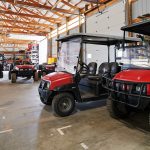Six Tips to Get Your Equipment Ready for Winter Storage
This is part of a continuing series of “how-to” articles to help you maximize performance and productivity with Toro® products.
After a busy summer season, you’re probably ready for some downtime. Much of your equipment probably is, too. Spend a little time to prepare it for winter storage now and you’ll save yourself time and headaches later. These six steps will not only help make spring preparations easier; they’ll also help maintain performance and extend the life of your machines.
1. Add Fuel Stabilizer
Stale, old gas can spell trouble for engines, no matter what climate you’re in. Gasoline breaks down over time as it becomes exposed to oxygen and it draws moisture. The breakdown begins to form gummy deposits in the fuel, which can cause an engine to run poorly. But there’s an easy solution: using a fuel stabilizer like Toro Premium Fuel Treatment.
Fuel stabilizers work in both 2- and 4-cycle engines. Just add one ounce of fuel stabilizer per two gallons of fuel before storing the equipment for the season. This will keep the fuel protected and fresh for at least 12 months. Another tip: You don’t need to store your Toro equipment with a full tank of fuel. A lower level of fuel is fine.
2. Drain and Rinse Your Sprayer
If you have a sprayer, you’re going to want to make sure it’s fully drained, cleaned and rinsed before putting it in storage. The chemicals that pass through your sprayer can cause corrosion, create clogs and damage parts, especially if left in the machine when it’s not in use.
To prepare your sprayer for storage, rinse and spray the tank out completely three times — or until the fluid runs clear. All accessories should be rinsed out as well. Then let the pump run to be sure the lines are purged and dry. This is especially important in colder climates where any residual water could freeze.
If you’re in a colder climate, you can also follow the cleaning by adding a pump conditioner or non-toxic RV antifreeze to protect the components. Put two to three gallons (7.5 to 11 liters) of pump conditioner in your sprayer and pump it through the system until it comes out of the nozzles. Then shut down your sprayer and store it with the pump conditioner left inside.
3. Check Batteries
Recommendations for batteries going into winter storage depend on the battery type. Before storing lithium ion battery-powered machines, charge or discharge (by operating the machine) the batteries to between 40% to 60% (50% is optimal). When batteries are charged to 100% before storage, this can shorten battery life. The temperature that batteries are stored at will also affect their long-term life, so it’s best to store the machine in a cool (not below freezing) location.
Lead-acid batteries should be fully charged, filled and in good condition before going into winter storage. If the battery is stored undercharged, the remaining charge will continue to deplete and the battery will lose its ability to work well. Plus, if the battery is partially discharged, the electrolyte inside can freeze and crack the battery case, causing a leak or even a complete battery failure.
Corrosion is another issue to look for. A dirty battery will discharge more than a clean battery, so it’s a good time to clean the terminal ends and put sealers on them as well. Keep in mind that if the battery is weak, it will need to be replaced eventually, and be prepared to put in a fresh battery in the spring.
4. Take Care of Oil Changes, Coolant and Greasing
Generally, Toro recommends changing the oil, greasing the machine and checking the coolant level to ensure the proper protection before storing the machine for the winter. Check your operator’s manual for recommendations on your machine. Even in warmer climates, it’s important to maintain a reasonable level of coolant mix — it’s not just for freezing, but also for boiling temp and conditioning. Corrosion inhibitors in the coolant also help protect metal cooling system components from corrosion, rust and scale buildup.
If you change the oil, be sure to use the proper engine oil viscosity grade or weight for your machine. Document any routine maintenance you perform so you’ll know when the next service is due.
5. Inflate Tires
Although flat spots aren’t a common problem, you definitely don’t want them on tires that will be driving on turf. To help avoid flat spots, you can inflate tires to the maximum pressure as indicated on the tire before storage to help the tire retain its shape. Just make sure you bring the inflation back down to operating level when you put your machines and trailers back in service in the spring.
6. Choose a Protected Location
While your equipment doesn’t need to be in a climate-controlled building, it should at least be kept dry. A shed or garage is ideal, but even covering it with a tarp is better than leaving it out in the elements.
If you have any questions about winterizing your equipment and preparing it for storage, contact your local Toro distributor.
More How-To Help
The how-to series is designed to help you get the most from your Toro equipment. If you missed any of the previous articles, just click on the titles below:
Extending Equipment Life With a Fuel Stabilizer
Extend the Life of Your Sprayer
How to Choose a Rotary Blade or Bedknife
Hose Maintenance Use Service Reminders to Ensure Timely Maintenance





